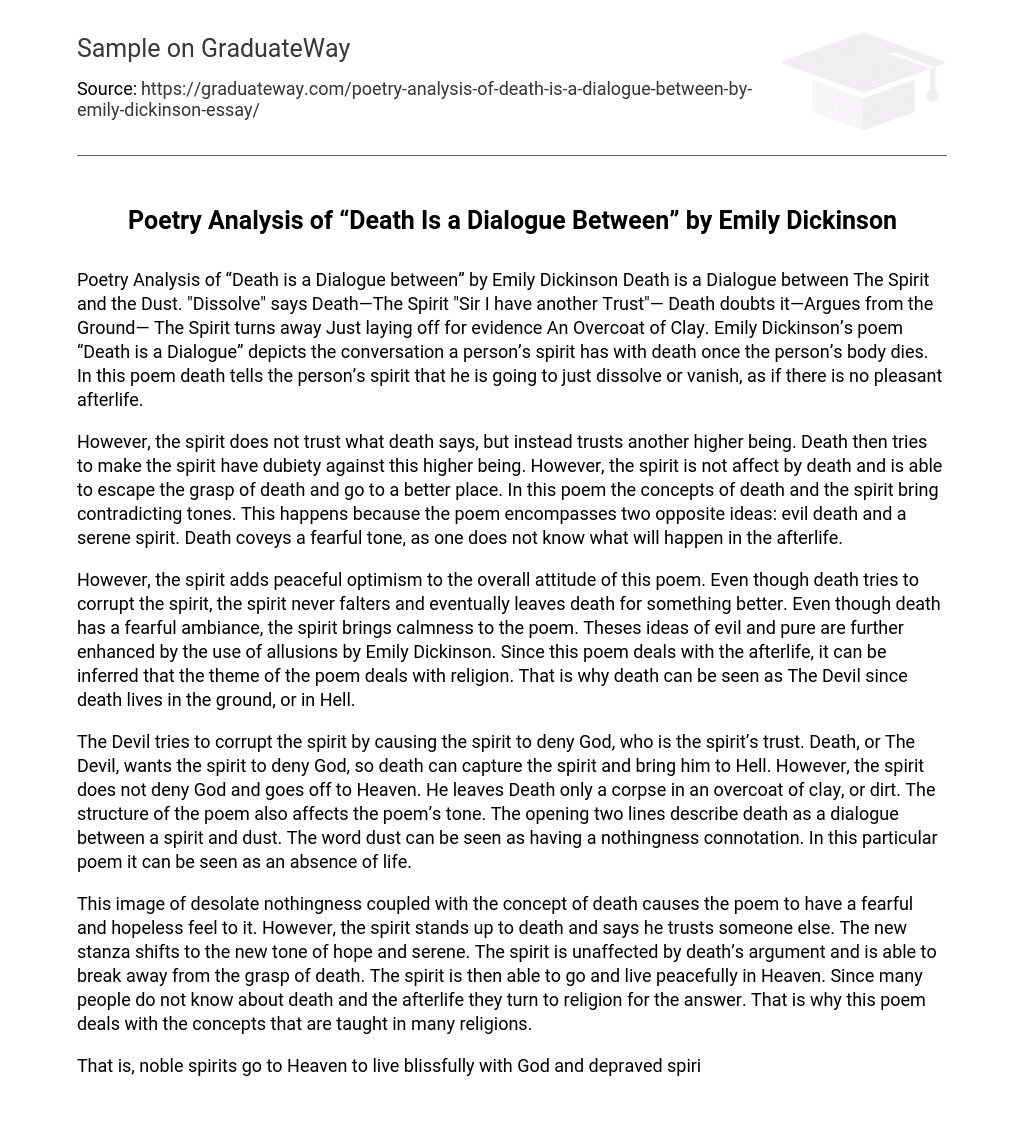Poetry Analysis of “Death is a Dialogue between” by Emily Dickinson Death is a Dialogue between The Spirit and the Dust. “Dissolve” says Death—The Spirit “Sir I have another Trust”— Death doubts it—Argues from the Ground— The Spirit turns away Just laying off for evidence An Overcoat of Clay. Emily Dickinson’s poem “Death is a Dialogue” depicts the conversation a person’s spirit has with death once the person’s body dies. In this poem death tells the person’s spirit that he is going to just dissolve or vanish, as if there is no pleasant afterlife.
However, the spirit does not trust what death says, but instead trusts another higher being. Death then tries to make the spirit have dubiety against this higher being. However, the spirit is not affect by death and is able to escape the grasp of death and go to a better place. In this poem the concepts of death and the spirit bring contradicting tones. This happens because the poem encompasses two opposite ideas: evil death and a serene spirit. Death coveys a fearful tone, as one does not know what will happen in the afterlife.
However, the spirit adds peaceful optimism to the overall attitude of this poem. Even though death tries to corrupt the spirit, the spirit never falters and eventually leaves death for something better. Even though death has a fearful ambiance, the spirit brings calmness to the poem. Theses ideas of evil and pure are further enhanced by the use of allusions by Emily Dickinson. Since this poem deals with the afterlife, it can be inferred that the theme of the poem deals with religion. That is why death can be seen as The Devil since death lives in the ground, or in Hell.
The Devil tries to corrupt the spirit by causing the spirit to deny God, who is the spirit’s trust. Death, or The Devil, wants the spirit to deny God, so death can capture the spirit and bring him to Hell. However, the spirit does not deny God and goes off to Heaven. He leaves Death only a corpse in an overcoat of clay, or dirt. The structure of the poem also affects the poem’s tone. The opening two lines describe death as a dialogue between a spirit and dust. The word dust can be seen as having a nothingness connotation. In this particular poem it can be seen as an absence of life.
This image of desolate nothingness coupled with the concept of death causes the poem to have a fearful and hopeless feel to it. However, the spirit stands up to death and says he trusts someone else. The new stanza shifts to the new tone of hope and serene. The spirit is unaffected by death’s argument and is able to break away from the grasp of death. The spirit is then able to go and live peacefully in Heaven. Since many people do not know about death and the afterlife they turn to religion for the answer. That is why this poem deals with the concepts that are taught in many religions.
That is, noble spirits go to Heaven to live blissfully with God and depraved spirits are damned to Hell. Emily Dickinson wants the reader to believe that a person’s spirit can have an afterlife. A person needs to be able to resist the temptations of The Devil and trust God. If a person does not fully have conviction in God, then their body and their spirit will not only die, but also suffer for enternity because of the Devil. Therefore, the theme of this poem is that in order for a person’s spirit to live on they must trust in God and deny The Devil.





